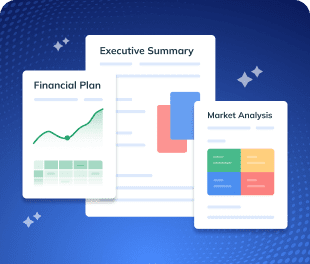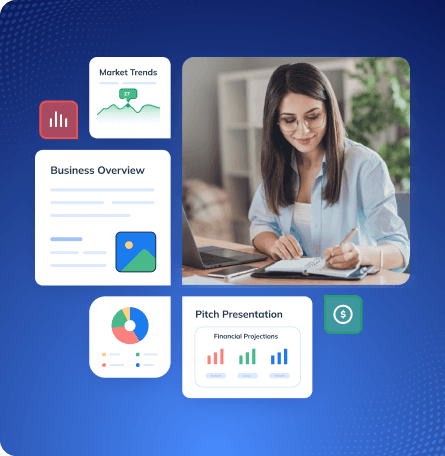Launching a convenience store? Well, that’s an exciting step with great potential!
You’re ready to be your own boss and build a store that serves the local community with convenience and essential products.
But opening a store without a solid plan can lead to missed opportunities and costly mistakes. To avoid that, you’ll need a well-thought-out business plan that helps you stay focused, set clear goals, and ensure long-term success.
Not sure how to draft?
Worry not! This convenience store business plan template will guide you through it.
Why do you need a business plan for a convenience store?
If you’re opening (or operating) a convenience store, a business plan may seem like something only the large chains require. But not necessarily.
A business plan serves to get you clear on what your store is about, who your customers are, and how you’re going to make it work. It’s not a set of goals on paper—it’s about giving your business some real structure and direction.
Here’s why it makes a difference:
- Stay clear about your goals: Rather than simply providing whatever products fall your way, a plan keeps you clear on what you’re actually providing, who your perfect customers are, and what success is for you.
- Plan your profits better: With a business plan in place, it’s simpler to determine your pricing, keep your costs in line, and establish sales goals that really work for your business.
- Track your money: A business plan assists you in keeping an eye on spending, such as inventory, employees’ wages, and advertising, and provides you with a good idea of how much profit you’re generating from sales.
- Get organized with your operations: If your processes are well-defined, you don’t need to spend time figuring them out again from the beginning each time. It keeps everything working well.
- Look more professional: Having a plan indicates to suppliers, investors, and even would-be partners that you’re committed to your business. It keeps you organized, prepared to make intelligent decisions, and follow through on your commitments.
In brief, a business plan doesn’t merely provide your convenience store with form—it streamlines your daily activities, allows you to reach your goals, and positions you for long-term success.
How to create a convenience store business plan?
Writing a business plan may seem overwhelming, but breaking it down into sections makes it easier.
Below, we’ve listed the key elements of a convenience store business plan and what to include in it. Follow these steps to create a plan that covers everything you need.
1. Executive Summary
The executive summary is a brief outline of your entire convenience store business plan. Think of it like a short pitch of your plan; it’s all about the highlights.
Although this section is written at the top of the page, most time it’s best to write it after you’ve described everything else. An excellent executive summary will grab the reader’s attention and make them want to read on.
Some basic questions you’ll need to ask yourself while writing this section:
- What is the registered business name? What is its legal structure? Where is it located?
- What type of convenience store are you opening?
- What is your target market? And how will you serve them in your store?
- What makes your convenience store different from other stores?
- What are your business goals?
- Are you looking for funding? If so, for how much/what?
Get it right, positive, and concise. An executive summary is simply a general overview of the plan without the need to go into detailed analysis. It should explain what your store is, why it will be successful, and what you need to get started.
Say goodbye to boring templates
Build your business plan faster and easier with AI
Plans starting from $14/month

2. Company Overview
The company overview section will give you a clear picture of your convenience store business, including things like who you are, where you are, and what you want to accomplish.
It is critical to convey your store’s concept, mission, location, and any legal aspects. The section also explains who owns the business and the future goals.
It’s your initial, detailed explanation of your business plan. It shows people what your business is all about.
Here’s what you should consider including in this section:
- Company information: Include your actual business name and type (LLC, sole proprietorship, etc).
- Location: Describe your store’s location, emphasizing its strategic advantages.
- Store concept: Explain the type of store ( size ) and what products/services you will provide.
- Mission & vision: Share your store’s mission and long-term vision.
- Founders/owners: Introduce the owners and their relevant experience or passion.
- Legal & regulatory: Include permits, and if it’s required by the local law.
The company overview is an important part of your business plan that contains the basic information on your convenience store. It lays out how the business will function, its location, its products and services, and what it can or will not do in the future.
Note that this section also needs to be concise and to the point to really emphasize what makes your store unique.
3. Industry and Market Research
In this section, you’ll show a solid understanding of the convenience store industry and the local market.
It typically covers a brief industry overview, then focuses on your specific market conditions, customer needs, and trends. This demonstrates that you’ve done your homework and understand the business environment.
Here are the essential elements to cover in your industry and market analysis:
Industry Overview
Mention the size and growth of the convenience store industry. For example, the U.S. industry saw $859.8 billion in sales in 2023, with foodservice being a major profit driver.
Target Market
Identify your customers and their needs. Describe the demographics and behavior of people in your area, such as office workers, travelers, or suburban families.
If required, you can add a simple customer persona that ideal customer’s needs, preferences, and shopping behavior. This helps customize your store’s products and services. Here’s a representation of a buyer persona:
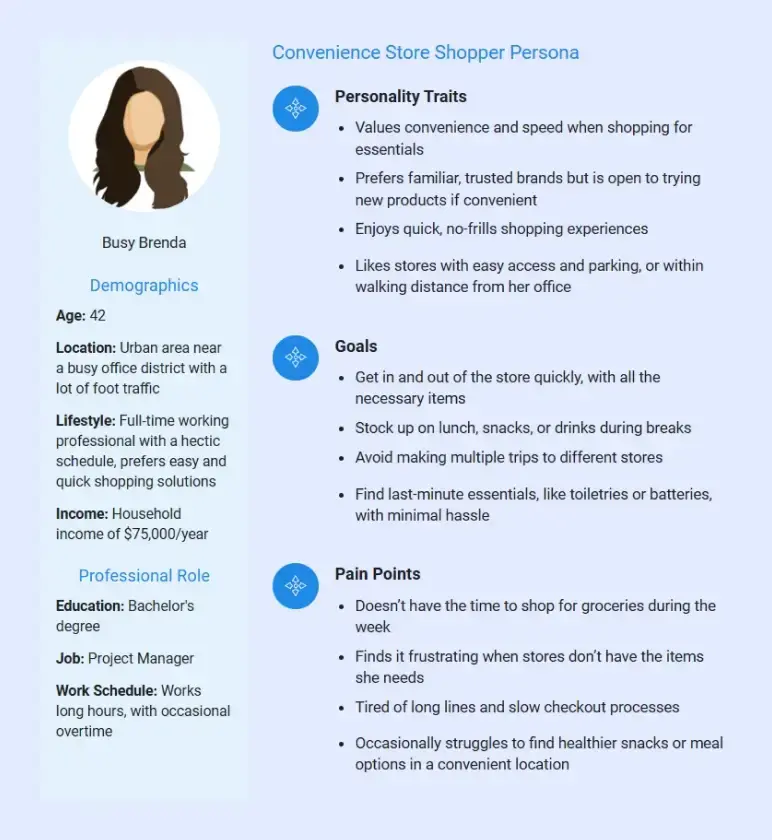
Location Specifics and Demand
Explain why your location is ideal based on store traffic, population growth, or community feedback.
Local Market Size
Estimate the market size by considering the number of potential customers and expected spending in your area.
Trends and Seasonality
Acknowledge local or seasonal trends that could impact your sales, such as school seasons or tourist traffic.
Using data and specific insights strengthens your business plan. It shows you understand your market and demonstrates demand for your store.
In short, a thorough market analysis will provide a strong foundation for convincing investors and stakeholders of your store’s potential for success.
4. Competitor Analysis
In any competitive market, understanding your rivals is crucial. Start by identifying direct competitors, which are other convenience stores or service stations in your area.
These stores target the same customer base and offer similar products. For each, mention their strengths and weaknesses.
Next, consider indirect competitors, which are businesses that aren’t convenience stores but could still draw customers away. These can include supermarkets, fast-food restaurants, coffee shops, or even online delivery services.
These competitors may impact your food and beverage sales or attract customers who prefer making larger grocery runs or ordering in.
Finally, think about how your store will differentiate itself from these competitors. Maybe your store will offer 24-hour service, fresh food, or a wider variety of products that others don’t carry.
Lastly, don’t forget to focus on competitive pricing, loyalty discounts, or a cleaner, more modern shopping experience.
By identifying and understanding your competitors, you can create a solid plan to carve out your share of the market.
5. Products and Services Offered
Now let’s talk about what exactly your convenience store will offer to customers. In a traditional sense, convenience stores offer a bit of everything – that’s why people love them!
In this section, detail the products and services your store will provide. Be specific and align it with what your target market wants.
You may offer one or more of the following products and services:
| Store Offerings | Items Included | Purpose/Use |
|---|---|---|
| Everyday Convenience Goods | Snacks, beverages, groceries, personal care items | Quick, on-the-go essential purchases |
| Food and Beverage Services | Coffee bars, hot food counters, sandwiches, pastries, ready-to-eat meals | Quick meals and snacks for customers needing immediate food |
| Fuel and Automotive Products | Fuel pumps, motor oil, air fresheners, automotive essentials | Vehicle fueling and maintenance for drivers |
| Lottery, Tobacco, and Alcohol | Lottery tickets, tobacco products, alcoholic beverages (as permitted by local laws) | Popular convenience items and important revenue sources |
You can tailor these products and services to meet the needs of your target market, whether they’re local residents, commuters, or college students, and highlight any unique offerings to stand out in the market.
6. Marketing Strategy
A strong marketing strategy is key to attracting and retaining customers. This section outlines how you’ll promote your store, reach your target market, and drive sales.
The following are the key elements to include in this section:
Unique Selling Proposition (USP)
Define your store’s USP, like “the only 24-hour store” or “healthiest snack selection,” and highlight this in your marketing materials and messaging.
Pricing and promotions
Explain your pricing strategy, such as competitive pricing on key items or affordable deals like “Buy a sandwich, get a half-price drink.” Mention any loyalty programs or grand opening offers.
Channels and tactics
Use local advertising (flyers, mailers, ads) and an online presence (Google Business Profile, website, social media) to engage customers.
Sales strategy
Focus on converting marketing leads into sales by using strategies to increase sales and build long-term customer relationships. Track foot traffic and sales growth to measure success.
By implementing a focused and cost-effective plan, you’ll attract and retain loyal customers.
7. Operations Plan
The operations plan is about the day-to-day running of your convenience store and how you keep things organized without missing a beat.
Here’s what to include in this section:
- Where is your store located? Is it a standalone store or part of a shopping center? Briefly describe the layout.
- What hours are you open? What are your store hours? Is it 24/7, or do you have set hours?
- What tools do you use? What systems or tools help you manage inventory, sales, and shifts?
- How do you manage inventory and deliveries? How often do you get deliveries, and how do you track stock? Do you use a POS system to keep everything updated?
- How do you handle staff? How many employees work each shift? What roles do they fill, and how do you schedule them?
- How do you communicate with your team and customers? How do you stay in touch with your employees and customers?
- How do you manage everything? How do you stay on top of tasks like restocking, customer service, and managing inventory?
A solid operations plan builds investor confidence, showing that you’ve thought through the practical side of running the business.
8. Organization and Management Team
Who’s running the show?
This section focuses on the people behind the business, essentially, your team and organizational structure. It highlights who is behind the convenience store and why they’re capable of making it succeed.
Start by introducing yourself if you are a solo entrepreneur. Include your name, role, and relevant experience.
If you have partners or key team members, introduce them as well. For each person, mention their role and background. Describe how your team is structured.
Additionally, you can include a basic organizational chart to illustrate your business’s team structure and the decision-making flow. For instance:
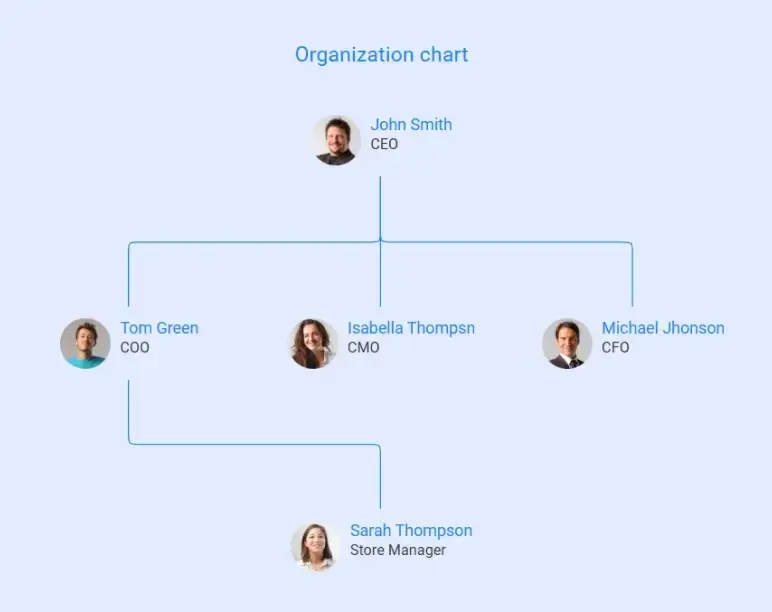
Finally, mention any advisors or consultants helping with the business. This shows that you have additional guidance and support to ensure your business runs smoothly.
9. Financial Plan
Now it’s number-crunching time. The financial plan is one of the most critical parts of your convenience store business plan, especially if you’re seeking funding.
It outlines the financial projections for the next few years of operations and demonstrates that your business can be profitable.
Here’s what your financial plan should cover:
- Startup costs: List one-time expenses like lease, equipment, inventory, and marketing.
- Sales projections: Estimate revenue based on customer count, average purchase, and seasonal growth.
- Operating expenses: Include monthly costs like rent, utilities, payroll, and insurance.
- Profit margins: Estimate gross margins on sales and net profit for the first two years.
- Cash flow considerations: Include a cash flow projection showing money flow and working capital needs.
- Funding request: State how much funding is needed, how it will be used, and repayment plans.
To make it clearer, you can include a pie chart showing how the startup funds will be allocated. Something like this:
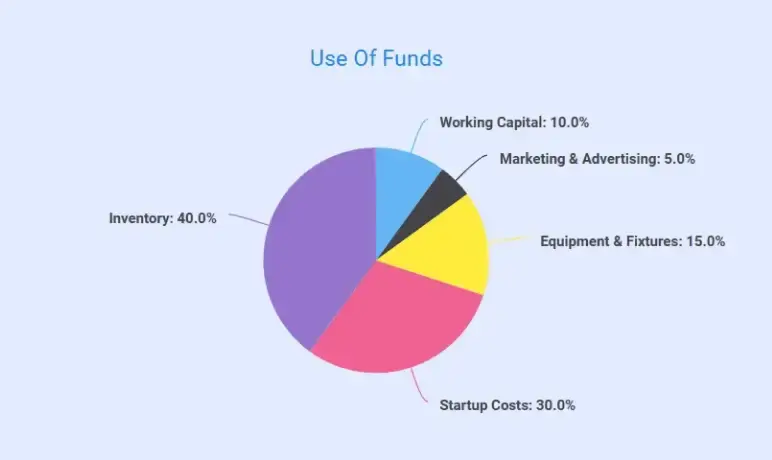
Further, try to present financials clearly with tables for Year 1, Year 2, and Year 3, showing revenue, expenses, and profit. For instance:
Income statement
| Particulars | 2024 ($) | 2025 ($) | 2026 ($) |
|---|---|---|---|
| Sales Revenue | 450,000 | 480,000 | 510,000 |
| Other Income | 12,000 | 13,000 | 14,000 |
| Total Revenue | 462,000 | 493,000 | 524,000 |
| Cost of Goods Sold (COGS) | 260,000 | 276,000 | 292,000 |
| Gross Profit | 202,000 | 217,000 | 232,000 |
| Operating Expenses | 112,500 | 116,835 | 121,211 |
| Operating Income | 89,500 | 100,165 | 110,789 |
| Interest Expense | 2,000 | 1,800 | 1,600 |
| Net Income Before Taxes | 87,500 | 98,365 | 109,189 |
| Income Taxes (25%) | 21,875 | 24,591 | 27,297 |
| Net Income | 65,625 | 73,774 | 81,892 |
Be conservative and realistic in projections, slightly underestimating sales and overestimating costs.
10. Appendix
The appendix is the final section of your convenience store business plan. It includes extra information or documents that support your plan but didn’t fit into the main sections.
You only need an appendix if you have additional materials to share. It helps keep your main plan neat while still providing important details for anyone who wants more information.
Items to include in the appendix of a convenience store business plan might be:
- Permits and licenses: Copies or details of necessary business licenses, health permits, and alcohol/tobacco licenses.
- Lease agreement or LOI (letter of intent): If the store location is secured, include the lease or Letter of Intent to confirm the location and rent terms.
- Detailed financial projections: Full financial statements for 3-5 years, Income Statement, Cash Flow, Balance Sheet.
- Market research data: Relevant demographic or survey data supporting your market analysis.
- Supplier agreements: Contracts with suppliers or franchise agreements to show an established supply chain or brand support.
The appendix helps keep your main plan short while still giving extra details for anyone who wants to see more.
Not everyone will read it, but it can help convince someone by showing you have all the facts. With all sections done, your business plan is ready to help launch your store and attract investors or partners.
Download a free convenience store business plan template
Need help writing your own convenience store business plan from scratch? Don’t worry! We’ve got you covered—download our free convenience store business plan PDF to get started.
This professionally designed business plan template is created specifically for convenience store owners and retailers. Use this example as a reference while writing your own plan. You can also customize it to fit your store’s unique offerings, target market, and business goals.
The Quickest Way to turn a Business Idea into a Business Plan
Fill-in-the-blanks and automatic financials make it easy.
Conclusion
We’ve covered all the key parts of a convenience store business plan, from your products and services to operations, marketing, and financial goals. You also got a free sample plan to guide you through the process.
Whether you’re starting fresh or updating an existing store, a clear plan will give you the confidence to move forward.
If you’d rather skip the formatting and focus on your store, Upmetrics can help. It’s an AI-powered tool that simplifies business planning, from market research to financial projections.
Try Upmetrics today and bring your convenience store vision to life!
